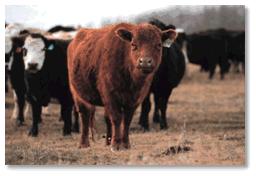| | Acute lead toxicity in cattle occurs as a result of consumption of feed contaminated with lead or access to a source of lead such as old batteries from automobile and farm machinery, lead based paints and used engine oil. Based on a recent study from Australia, used engine oil from vehicles using unleaded gas is no longer a major threat of lead source (1). In Canada the use of leaded gasoline has been prohibited since 1990 under the Canadian Environmental Protection Act (CEPA) (2). Lead based paints for indoor use produced in Canada and the US after 1992 are virtually lead free (2), however there may still be a significant exposure hazard to animals that have access to old outbuildings (before 1950) painted with lead based paint. Lead will remain in the ashes of buildings painted with lead based paint and subsequently burned. The ashes therefore may also be a source of exposure.
Exposure to toxic levels of lead can lead to sudden death or to permanent brain damage thereby requiring humane destruction and proper disposal of affected animals. Sudden death in healthy calves and cows is the main presenting complaint by the producer to their veterinarian. Calves and cows that appear blind, wander aimlessly and are often separated from the rest of the herd are also common observations reported by producers. From the cases reported to us to date, all age groups of cattle were affected; however young calves were more commonly affected.

Cattle, which have been exposed to a source of lead, can have elevated levels of lead in their blood without showing any outward signs of clinical disease. The blood lead levels in these cattle can remain elevated above the maximum acceptable concentration of 0.11 ppm for an extended period (3). It is important that we identify the cattle with elevated lead levels and take precautions to prevent products such as milk and meat from these animals entering the human food chain until the levels have declined below the maximum allowable limit. Therefore, when acute lead toxicity is confirmed in an animal, the entire group of potentially exposed animals must be tested for blood lead levels. In addition, the source of the lead exposure in the pasture must be determined and removed to prevent re-exposure of these or future animals using the area.
In January 2009, the new Animal Health Act came into effect. Under the Reportable and Notifiable Diseases Regulation, animals that are affected by toxic substances that are a threat to human or animal health must be reported to the Chief Provincial Veterinarian. Lead is the most common toxin reported. Lead levels above the maximum acceptable concentrations in meat (0.11 mg/kg), milk (0.020 mg/kg) and other products from cattle make these products unsafe and unable to enter the food chain.
Producers and private veterinarians have been diligent and cooperative in reporting cases of lead toxicity to the Office of Chief Provincial Veterinarian (OCPV). The Food Safety and Animal Health Division is monitoring exposed animals in affected herds in order to prevent meat and milk from animals whose blood levels exceed the maximum acceptable concentration from entering the human food chain.
All cases of lead exposure and poisoning in cattle reported to OCPV to date occurred in cattle grazing on pasture. In all cases, where the source of lead was identified, discarded lead acid batteries from automobiles and farm machinery were found. It is important that we reduce this risk of contamination of pasture and farmland with lead. Eleven percent of the exposed animals had blood lead levels above 0.11 ppm. Lead is a very stable metal and will remain in soil indefinitely. Cattle and especially calves find the metal tasty and will actively lick and consume it. Therefore, lead is a toxic hazard to animals which have access to areas where it has been inappropriately disposed.
Old used lead acid batteries from automobiles and other farm machinery should not be discarded on pasture or buried on farm. Lead acid batteries should always be sent for recycling as a hazardous waste. There are collection stations located around the province where these batteries can be dropped off. The batteries are then taken to companies where they are recycled and the lead is retrieved to be used again. To locate a station near your farm, you can call the Recycling hotline 1-800-463-6326 or you can visit the web page http://callcentre.emergeknowledge.com/. On the web page enter “Lead acid batteries” as the material you want to recycle, enter your postal code and distance within which you want to deliver the batteries.
There are also companies in Calgary and Edmonton who will accept your old batteries and compensate for the amount delivered based on the weight and the status of the battery delivered. The contact phone numbers are:
Edmonton: Interstate Battery Systems phone 780-454-4343
Calgary: Exide Technologies phone 1-800-465-6555 |
|